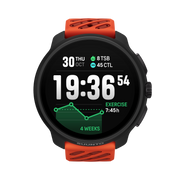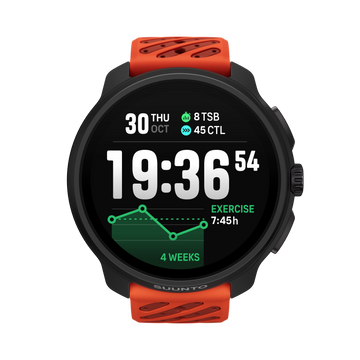

Suunto Blog

Big data for Vertical Week 2019 is here: find out who came out on top!
Like every year after World Vertical Week, our data analysts have combed the stats collected on Suunto app and presented us with the countries and sports that have climbed the most.
When we crunched the statistics from all the training around the world during Suunto World Vertical Week 2019, we felt our hard work had paid off. It had given you all the excuse to chase meters outside, whether on behalf of your nation, chosen sport or for your own challenge – exactly our intention.
There’s something about the sight of a hill or mountain in front of us that calls us to push ourselves. The challenge of the ascent is just as satisfying as the view from the top. That’s why we do it! Well done to everyone who participated.
Top countries
This year, we first report a major upset. In the previous two years, Austria has come out on top as the nation that achieves the most vertical gain by average. Not this year – the Alpine nation has been knocked off its perch. This year, Italy, Slovakia and Slovenia, all mountainous nations, climbed more than Austria. But more surprising, Portugal also came in ahead of Austria.
In the last two years the Swiss have also come in near the top, but this year they have dropped to the eighth position. What’s happened in Austria and Switzerland? Someone tell us!
Honorable mention
This year, Spain deserves an honorable mention. Spain came first in three divisions: totals per country, mountaineering, and trekking. It was also in the top five for four different activities: mountaineering, trekking, mountain biking and cycling. All up, Spain features in six of the nine country-related lists below, the only country to do so. Well done Espana!
Here are the results by nation
While these numbers might not seem so mind-blowing, remember they are averages, and a high average is indicative of many big days out in the hills.
Italy 385 m
Slovakia 360 m
Slovenia 346 m
Portugal 342 m
Austria 337 m
Spain 308 m
Switzerland 288 m
France 283 m
Canada 276 m
Norway 261 m
Totals per country
This year we also decided to look at the totals per country. In these countries, World Vertical Week participants have been really active and gotten out there to climb, even only a little, to add on their country’s total number. These little efforts have added up.
Spain 645.000 m
France 546.000 m
Italy 379.000 m
United States 377.000 m
China 250.000 m
Austria 216.000 m
United Kingdom 183.000 m
Japan 150.000 m
Norway 142.000 m
Switzerland 140.000 m
Average ascent by activity
At least as interesting as the country numbers are the activity specific stats. From these, we can see that skiers clearly put in the biggest average days. Trail running and mountain biking are probably under-represented because it’s winter in the populous Northern Hemisphere.
Like Vertical Week 2018, ski touring, mountaineering and trail running came out on top this year. The question is, which nations did the most of each?
Ski touring 830 m
Mountaineering 594 m
Trail running 474 m
Mountain biking 355 m
Trekking 311 m
Hiking 213 m
Nordic skiing 199 m
Cycling 193 m
Running 100 m
Activity by country
Ski touring
France 1127m
Italy 1085m
Austria 864m
Switzerland 828m
Germany 776m
Two countries pass 1000 m of vertical gain by average!
Mountaineering
Spain 1071m
UK 947m
Poland 798m
USA 716m
Germany 651m
Trail running
Hong Kong 1176m
Japan 901m
Malaysia 813m
China 765m
Portugal 713m
Asia dominating, showing the growing popularity of the sport in the region!
Mountain biking
Italy 476m
Slovakia 474m
UK 437m
Spain 422m
Austria 394m
Cycling
Colombia 499m
South Africa 485m
Israel 446m
Spain 438m
Italy 363m
These nations have favorable weather for cycling in March!
Nordic skiing
France 379m
Canada 321m
USA 285m
Norway 243m
Austria 212m
Trekking
Spain 566m
Italy 527m
Malaysia 363m
Italy 362m
Poland 304m
Individual top performances
While we can’t give away too much information here, such as who and where, we can share some insight in the individual top performances over the week: To be on the pointy end of the rankings one had to climb more than 10000 meters over World Vertical Week. And to stand out with a single activity one had to climb 4000+ meters in one go!
Thank you, everyone, for participating!
Read three inspiring stories from the World Vertical Week!

Chasing meters: top stories from Vertical Week 2019
The fourth annual Suunto Vertical Week is coming to a close and we have selected three winners of the week’s photo contest on Instagram. Each of them will receive a powerful Suunto 9 to record their efforts! We received many other inspiring images and stories (#verticalweek) – thanks to everyone for their contributions! Keep climbing!
Baby in tow in Norway
We were very impressed by Hilde Hoff Nordskar in Norway. She climbed 3246 m in a week, while towing her seven-month-old baby boy, who slept through it all. Some have it easy! Well done, Hilde!
“Vertical Week was overall very hard and fun and brought some new inspiration to my maternity leave,” Hilde says. “We live close to a forest and my daily goal was to summit the top of a nearby peak called 'Solobservatoriet' (580 m). With my seven-month-old son in the wagon behind, I started every morning skinning up the hill no matter the weather. The highlights was to experience the uphill in all these different winter wonderland conditions and finish every session with a big smile on my face and a very rested kid.”
View this post on Instagram
Punta di Terrarossa 🏔 3246 meters climbing in a week 🎿👶🏻 #VerticalWeek #Suuntoapp @suunto_norge @suunto @thule #thulebringyourkids #dæhlie
A post shared by hildehoffnordskar (@hildehoffnordskar) on Mar 9, 2019 at 8:48am PST
Big training block in California
Eric Triplett in sunny California enjoyed a big week, climbing 3500m. This beautiful shot of sunrise from Mount Wilson illustrates the motivation behind the call to scale peaks; massive rewards for our hard work.
“Suunto Vertical Week was the perfect way to finish up a three month training block for my upcoming race,” Eric says. “The race features 3000 m of climbing over 56 km so my primary goals for Vertical Week were to simulate the amount of gain relative to the distance of my race and to accumulate at least 3000 m of gain. I’m happy to say I was able to complete 3500 m for the week including a 33 km run with 2100 m of vertical. Thanks to Suunto for putting on this motivating celebration of vertical!”
View this post on Instagram
The sun rises on the last day of #VerticalWeek 2019 // It’s been a while since I’ve cracked 11,000ft of gain in a week so I made it a goal given both Vertical Week and that 9 Trails is coming in just two weeks. Admittedly going beyond 10,000ft seems to bring on the sore knees and other random leg pain but that only serves to highlight what to work on in the future // Been super excited about getting my hands on “Training for the Uphill Athlete” by House, Johnston and Jornet. I think it’s going to help take things next level. // I’m also very happy with where @Sagerunning training has taken me in the last 3 months. I’ve never thought I could maintain the kind weekly mileage that I have for so long. I was always afraid to put intervals into 20mi+ runs but I survived. It hasn’t been easy but listening to my body and making small adjustments has got me through. // #utlrarunning #trailrunning #runinrabbit #borntorunfree #rabbitTrail #RADrabbit #gotailwind #timetoplay #salomon #suunto #salomonrunning #9T #NineTrails #sagerunning #SanGabrielSunday #longrun #ANF
A post shared by Eric Triplett (@fleshymutant) on Mar 10, 2019 at 9:08pm PDT
New season in Finland
Janne Korpela in Finland has begun a new training block now spring has nearly arrived. It hasn’t been in a walk in the park, either, on some days finding himself waist deep in snow. Keep going, Janne!
“Vertical Week was surprisingly good, since it was only the third proper training week of the year for me with 19 hours of training,” he says. “The highlight of the week was the first day, when a six hour session was surprisingly easy. And last Sunday was a beautiful spring day!
“The goal was 8000m in eight days, but we pushed it a bit yesterday to climb the height of Everest (8848 m)! I did all the climbing on an old ski slope close to my home. One lap is about 35 meters of climbing!”
View this post on Instagram
A post shared by Juosten (@juosten_) on Mar 10, 2019 at 6:02am PDT
Lead image: © Dylan Totaro / Suunto

Suunto World Vertical Week 2019
For some of us a climb is a challenge, an obstacle to overcome. With training we get stronger and can climb the same hill easier – or faster. But it usually does not last long before we set our eyes on even bigger or faster or more challenging climbs.
For others a climb is an adventure, a promise that once we reach the top, col or ridgeline new horizons will open up and broaden our views and, on the way down, we will get to play with gravity.
Whatever your motivation, Suunto’s annual Vertical Week is here again!
Suunto World Vertical Week 2019 starts on Sunday, March 3rd and ends on Sunday, March 10th.
Put on your running shoes, hop on your bike or release your heels and start skinning up the hill. Track your adventures with your Suunto watch, upload your activities to Suunto app and, by the end of the week, we’ll know who climbs the most in a week. And it’s not only about individual performances: we want to see which country averages most vertical during the week and which activity takes you up the biggest climbs.
To participate, join the challenge in Suunto app!
SHARE YOUR EXPERIENCE AND WIN A SUUNTO 9
Share your Suunto World Vertical Week experiences on Instagram using Suunto app’s photo sharing with data overlays and use tag #VerticalWeek. Three of the most inspiring posts will win Suunto 9 watches.
Terms and conditions apply. Read them here.
Learn how to share your activities using Suunto app
Don’t have Suunto app yet? Get it now!

Four pointers for running while pregnant
© Lymbus/Sergi Colomé
Being pregnant has meant Emelie Forsberg has had to make some adjustments to her schedule, and reduce the volume of her training. However, it hasn’t stopped her running. While she is taking more care, she is trying to stay active for as long as she can.
“I think (running while pregnant) is so individual, so you can’t compare one woman to another,” Forsberg says. “My first priority is always to listen to my body, especially now that I’m pregnant. I will try to stay active as long as I can. I don’t have any niggles or problem so far.”
According to Andrew Shennan, professor of obstetrics at Kings College in London, running while pregnant is perfectly safe if not overdone. Many people, he says, have misunderstandings about women’s bodies during pregnancy. They are capable of more than you might think.
“Pregnancy is quite a profound state in terms of how it changes your body, however it’s not that delicate,” Shennan says. “In fact, all the evidence says that staying fit and healthy and continuing exercise is a perfectly reasonable thing to do.”
© Lymbus/Sergi Colomé
1. Running is safe (within reason)
Shennan and his colleagues did a study on 1200 pregnant runners. The study compared those that stopped running with those that continued, and then compared those that continued into different phases of pregnancy, and also by their running volume, and those that stopped. The study found the pregnancies of women who chose to give up running were no different from those who continued to exercise throughout their pregnancy.
“All the evidence on moderate exercise and recreational exercise is that doing it regularly and consistently does not influence when you go into labour, or the way your baby grows and develops,” Shennan says. “You can be reassured that mild exercise is perfectly reasonable.”
2. It’s actually a good thing
Not only is moderate, regular exercise safe, it’s also a good thing. Shennan says there is good evidence that being a good weight and physically fit is helpful for pregnancy and during labor.
“From a general point of view we encourage women to exercise about 30 minutes everyday,” he says. “Entering pregnancy at an optimal weight is a very good prerequisite for a healthy pregnancy. We know that healthy pregnancies create healthy children. Being fit and healthy will programme your baby in utero for lifelong health.”
Professor Andrew Shennan is Professor of Obstetrics at King’s College London, based at St. Thomas’ Hospital.
3. Don’t push it
Yes, running is safe and even healthy, but caution is required. Because pregnant women pump 40 % more blood, their hearts have to work harder, increasing their average heart rate.
“The placenta is very sensitive to blood flow and doesn’t have autoregulation like other organs have,” Shennan says. “This means that if you are becoming a bit hypoxic (low in oxygen), it will have a direct effect on the placenta. Therefore, it’s really important not to push it. If you are running in the red zone that’s probably not a good thing. I would stay within your comfort zone, and listen to your body.
“Remember the benefits you get from exercising at suboptimal levels are often underestimated. Focus on maintaining your fitness while pregnant rather than trying to gain.”
4. Avoid falling at all costs
Hormone activity in pregnancy softens ligaments, and reduces bone mass, increasing the risk of injury. The ability to balance and posture change in the second and third trimester. All of this means women can become more injury prone.
“The lesson is be careful and not to do crazy things,” Shennan says. “The one big thing to avoid is trauma. We know that trauma, direct impact to the uterus, is a bad thing. If you have a little fall, and you knock your bump, there can be what we call subclinical bleeds behind the placenta and they can build up and cause a catastrophic event a day or two later. So even minor trauma is not good thing.”
Final word: enjoy your running
When Shennan was conducting the study of 1200 pregnant runners, one woman contacted him to ask if she should continue running. She said she had cut down her training volume to 20 km a day. Shennan said he didn’t know whether that was safe. She continued running in this way and encountered no problems during her pregnancy or the birth.
“As an obstetrician, I’m not encouraging woman to do that because I think it’s probably a bit much,” he says. “However, I do encourage pregnant woman to carry on doing their accustomed exercise. Just be prepared to slow down a bit.”
Lead image: Photo by Curtis MacNewton on Unsplash

3 Ways to Motivate Yourself to Train This Winter
On the whole we endurance athletes are a pretty self-motivated bunch. But even endurance athletes are only human, and as a result we suffer from the same fluctuations in “get up and go” as everyone else from time to time. These dips in motivation can range from the nagging desire to skip training for a day or two to full on slumps where you lose your workout mojo altogether for extended periods of time.
And this time of the year can be particularly challenging from a “mojo” point of view because, for the most part, the “A” races for the year have disappeared into the rear view mirror but next season is still a good way off over the horizon.
There are also dark mornings and evenings with often colder, wetter weather to contend with (for those of us in the Northern Hemisphere at least). At this time of the year it’s easier than ever to just skip training altogether.
Don’t get me wrong, I do believe in taking a decent end-of-year break if you’ve had a long, hard season. This is crucial for mental and physical recuperation. But, assuming that your planned downtime is coming to an end sometime in the near future, I thought it might be a good time to offer up a few tips gleaned from more than 20 years of tricking, cajoling and persuading myself to go out and train when frankly I’d much rather have hit the snooze button or spent more time working on the Homer Simpson-esque butt indentations in my sofa instead.
Set your next goal ASAP
Over the years I’ve learned that lining up your next significant goal is the best way to motivate you to train. It’s why I’ve tried to carry on doing a fairly big event each year even though I’m nowhere near as competitive as I used to be.
I simply find that without something fairly challenging in the diary in the not too distant future, I am far more likely to give in to the urge to skip a session when I just don’t feel like it. Without a significant goal on the horizon, I find that something of a downward spiral kicks in. Missed workouts lead to a significant drop in fitness levels followed by similar drop-offs in mood, self-confidence and overall productivity in life.
In contrast, when I have a decent high-level goal in place the opposite tends to happen. Aiming for the goal has a positive “double-whammy” effect on my motivation and willingness to put the work in. It gives me something very positive to visualize and strive toward when I’m feeling motivated and up for training anyway, acting as a kind of multiplier of effort and enjoyment on those days.
And even more importantly, it does a great job of mildly scaring and pressuring me into making that crucial first step out of the door on those days where I’m feeling less than up for it. That’s largely because I’m fearful of the consequences of not doing so; namely falling short of the goal in some way.
I’m actually going through the process of choosing a couple of goals for the year at the moment. If you’ve not set your mind to what you want to be doing this year yet, I’d definitely recommend doing so soon.
Plan to train with other people
Training with other people adds the pressure of not letting them down and this alone is a powerful motivator. Training with others can also be a lot of fun and it can help distract you a bit and give you another, more sociable reason to go training.
I’ve always found evening training to be the hardest to get motivated for. I’ve therefore taken to arranging to go training with other people on days where my work schedule dictates that I have to put sessions in after dinner rather than first thing in the morning (which I definitely prefer).
More often than not, the pressure of having to show up and not let someone else down is the deciding factor in getting me out and putting in the miles. And, somewhat unsurprisingly, I almost always find that I either enjoy the training once it’s underway or at the very least get a sense of satisfaction from it once it’s done.
Plan tomorrow, tonight.
Having the discipline to spend two minutes at the end of each day thinking about what training you’re going to do the next day can be hugely beneficial.
When you’re working to a set training plan this mental checklist is nothing more than a brief chance to think through what your program has in store; to make sure you feel like you’re up to it and to check you have everything you need ready (kit/equipment laid out or packed, alarm set for the right time, any foods and drinks prepared etc).
This reduces the chances of anything small or silly preventing you from getting the job done the next day and it allows you to adapt your plan if you feel you need to.
When you’re not working to a long-term structured plan (as can be the case at this more relaxed time of year), taking a couple of minutes to plan out what you intend to do tomorrow, and when you intend to do it, is even more important. It dramatically increases your chances of actually knuckling down and doing some productive training.
I’ve done a fair bit of reading on this subject (as well as thinking about my own tendencies) and I think this is largely because we have 3 different “selves”: our Past Selves, Present Selves and Future Selves. The implications of this theory go way beyond training, but here’s my extremely basic interpretation of how it applies to athletes:
Your Present Self almost always wants to do something that’s easy and rewarding right now e.g. hit snooze and stay in the warm bed, or stay parked in front of the TV. However, what your Future Self would actually benefit from most of all is doing something harder right now, i.e. getting your kit on and going training, as this will result in your Future Self being fitter in the long run.
In other words, your Future Self needs your Present Self to take some pain now for gain later on, whereas Present Self is far more interested in avoiding the pain in the immediate term. It’s as if you’re actually two different people with two different sets of goals.
So, when you sit down the night before the following day to mentally commit to what training you’ve got planned, what you’re actually doing is proactively putting your Future Self’s best interests to the fore whilst you’re not feeling the strong pull of Present Self’s desires.
When the alarm goes off the following morning, you wake up having effectively made a pact with your Past Self to get up and go to give your Future Self the best shot at hitting their goals. This makes it quite a bit harder for Present Self to take the reigns and simply turn off the alarm and roll over.
The psychology of human motivation is clearly more complicated than this simplification, but I do know from my own experience that thinking about things in this way (and pre-agreeing the following day’s training the night before with myself) is a very helpful tool for getting me up and out of the door.
Success with endurance training is largely a product of the consistency with which you can grind it out over many months, so I hope that these tips help you get out of the door just a little more regularly in the coming weeks and contribute to you starting the new year with the best possible chance of having a great season.
This article by Andy Blow, a coach and a triathlete, was originally published on trainingpeaks.com.
TrainingPeaks provides you in-depth analysis, planning tools and coaching services to help you reach your goal. Track your workouts with your Suunto watch. Afterwards analyze your heart rate, power, pace and other data with TrainingPeaks on web or in mobile and progress towards your goals.
READ ALSO
TAKE THE LONG LOOK: HOW TO PLAN (VERY) FAR AHEAD IN ORDER TO REACH YOUR GOALS
3 THINGS YOU NEED TO DO BEFORE SETTING YOUR NEXT RACE GOAL

Fuelling the engine: Talking nutrition with Ryan Sandes
Avocados are a staple in Sandes’s diet. © Craig Kolesky / Red Bull Content Pool
Back home in his native South Africa, ultra runner Ryan Sandes is partial to a good braai (the South African version of a barbeque). While he generally eats whole foods most of the time, Sandes avoids getting strict or uptight about his diet. He takes a pragmatic approach.
“I believe it's important to enjoy life as well,” he says. “I don’t weigh x amount of protein, and x of carbs, I just try to eat a balanced diet with as many whole foods as possible. I try to listen to what my body is craving.”
Despite being from meat loving South Africa, Sandes and his wife Vanessa have drastically reduced their meat consumption to only once or twice a week. Instead, they focus on eating unprocessed, natural food.
“As an athlete it’s very easy to slip into taking lots of recovery shakes to try to get the goodness back into your body,” Sandes says. “But I don’t think you can replace eating good whole foods.”
Sandes ran the Great Himalayan Trail this year. © Dean Leslie / Red Bull Content Pool
In busy times
Forward planning is essential for athletes. And having a good meal plan is just as important as having a clear training plan.
Sandes often makes a big dish, with multiple portions, at the beginning of the week so he has something easy available if it’s a busy week. It’s helpful doing this, he says, because of the tendency to get a little lazy, especially later in the week.
“I often eat quite a lot of eggs, and avocados and salad, things that are easy to put together,” he says.
Sandes (and his dog) remains partial to a braai (barbecue). © Ryan Sandes
Go to meals
Sandes enjoys pizza so, when he needs an easy meal, he buys locally made pizza bases, smothers them vegetables and salad, and bakes them. Burgers, smoothies, rye bread with honey, muesli and plenty of boiled eggs are all part of his regular diet, too.
And his secret supplement is bone broth.
“These days in first world countries people eat the best cuts of meat, whereas way back in the hunter-gatherer days, if they hunted a buck they would eat the entire animal, including boiling all the bones and drinking the broth,” Sandes explains. “A lot of the good meat cuts don’t have all the essential fats, but bone broth has that. It’s not my favourite thing, but it’s great for recovery.”
The Sandes superfood grain salad recipe
Grains:
1 cup of quinoa1 cup of sorghumHalf a cup of milletHalf a cup of buckwheat
Boil all the grains separately as they all have varying cooking times.Add a can of drained and rinsed chickpeas and a can of drained and rinsed lentils.Let the grains cool down and add some lemon juice and good quality olive oil. The above amounts make quite a big bowl but you can keep it in the fridge and decant from it all week for lunch and dinner!
Other ingredients:
Chopped up avocado pearRocket and other lettuce leaves Baby spinach leavesFeta cheesePitted olivesBaby tomatoes
Salad dressing:
1/4 cup of balsamic vinegar1/2 cup of good quality cold extracted olive oil1 teaspoon of honey1 teaspoon of whole-grain or Dijon mustardOne clove of crushed fresh garlicSalt & pepper to taste
Blend all the salad dressing ingredients and lightly drizzle onto your salad. For more of an animal protein punch, add slices of grilled chicken, beef or tuna. Optional extras: drained and rinsed can of corn, chopped up fresh basil, drained and rinsed butter or cannellini beans, cut up cucumber, half a hand-full of dried cranberries.
Lead image: Photo by Jaco Pretorius on Unsplash
Read more stories about nutrition:
Fuelling the engine: A common sense approach to nutrition
Fuelling the engine: Talking nutrition with Melissa Hauschildt
Fuelling the engine: Talking nutrition with Lucy Bartholomew































































